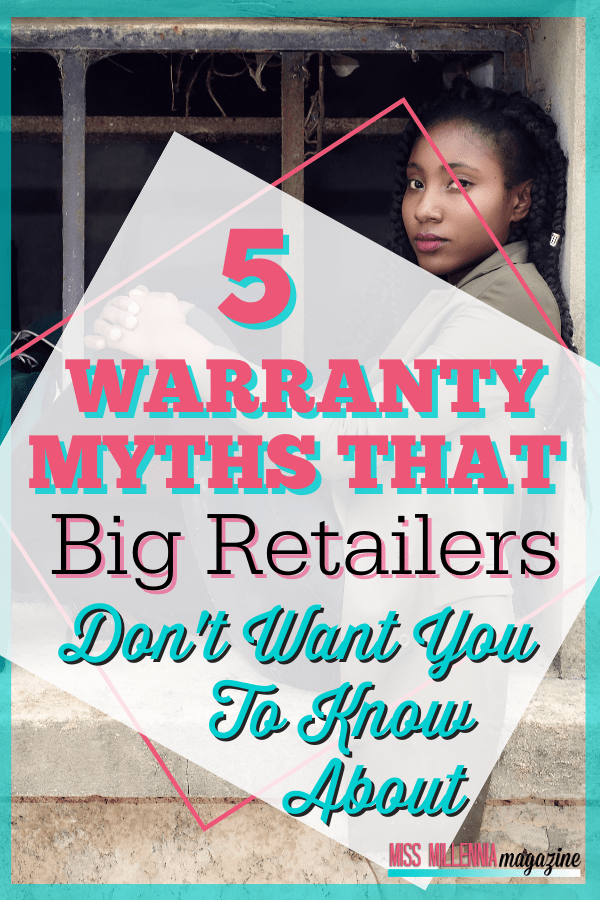5 Warranty Myths That Big Retailers Don’t Want You To Know About

During the pandemic, many people are doing more of their shopping online. One frequently encountered situation in online shopping is that retailers try to upsell people on retail warranties. There are a lot of warranty myths out there you might be aware of, so we’re here to set the record straight.
It probably feels like every time you shop online; the company is trying to get you to buy a warranty when you get to the checkout page. This is especially common for big box stores and big-ticket purchases like appliances and electronics.
However, it can also happen with items worth smaller dollar amounts. Even if you spend as little as $100 on a product, the retailer will likely ask if you want to pay $20-30 extra for a warranty or “protection plan.”
Are these extra costs worth it? Or is the retail warranty just a way for corporations to pad their profit margins?
Understanding the warranty myths and realities can help you be a savvier shopper, save money, and avoid getting stuck with an “unwarranted” warranty.
What Are Retail Warranties?
Retail warranties are also sometimes called extended warranties or “protection plans.” They are a form of insurance that a buyer can purchase to help cover the costs of repairing an item if it breaks during a specific period.
Warranties promise that if your product breaks, you can get it fixed or, sometimes, a new one.
Anyone who’s ever dropped and cracked their expensive iPhone will understand the relief from realizing that if they have a protection plan like AppleCare, their phone is still fully covered under warranty.
The same is valid for fitness equipment, which has experienced a boom since COVID-19: if your treadmill breaks down while still under warranty, it can save you hundreds of dollars in costs.
But here’s the problem: many big box retailers are pushing customers to buy overinflated warranties now on all kinds of products. And these retail warranties often are not a very good deal for you as a consumer.
If you’re not careful, you might pay too much for a warranty that will not help you if something breaks.
Warranties should not be confused with Guarantees. Are you not sure what the difference is? Watch the video below to learn more.
Weight The Pros And Cons
On the one hand, it’s good for consumers to be risk-conscious and want to be protected against the possible costs of repairing or replacing a faulty item. Sometimes, peace of mind can be priceless.
However, many retail warranties usually do not add enough value to be worth the cost. Budget-conscious millennials might want to avoid the extra expenses of retail warranties.
Not all retail warranties are worth paying for, and not all are the same. Don’t just buy a retail warranty because it’s being presented as an easy add-on option at the checkout.
Instead, if you examine retail warranties closely, you can get more value for your money and understand your options.
Let’s look at how retail warranties can work for you and how to avoid an unnecessary upsell that doesn’t make financial sense.
5 Warranty Myths You Must Know
Lets Review them.
Warranty Myth 1- You must buy a warranty at the point of purchase.
Reality: Warranties are great money makers for retailers, so consumers often get hit hard and fast with the sales pitch at the cash register. The salesperson doesn’t tell you that you can shop around for a product protection plan instead of buying a warranty at the point of purchase.
It’s a dirty little secret in retail—warranties are the store’s bread and butter.
With nearly universal online price transparency (thanks, Amazon!), margins at big retailers have been shaved to a minimum, forcing warranties and other auxiliary products and services to become their new profit centers.
Fortunately, if you adopt a “don’t take the bait and wait” mindset, you can find much better deals to protect those big-ticket purchases.
Consider a new company called Upsie, a modern warranty company that is onto something big. In contrast to retailers like Best Buy and Apple, Upsie is a more affordable warranty option for your electronic devices, appliances, and fitness equipment.
By cutting out the intermediary and making the entire process simple, accessible, and transparent online, Upsie can offer millennials significant savings on warranties—up to 70% less than retailers and smartphone carriers like Apple.
Bottom Line
Don’t rush the process of finding an exemplary protection plan. When you buy expensive products, avoid the pressure at the register and take your time to find the right warranty plan. Upsie gives you 60 days to 11 months after purchasing a new or used device, product, or appliance.
Warranty Myth 2: You are out of luck when you buy refurbished or used products.
Reality: Savvy deal seekers do not have to give up warranty protection. You may still have the option to cover your used or refurbished device. In challenging economic times like now, it can be a smart money move to buy used or refurbished, and doing so does not mean that you have to give up the peace of mind that comes with warranty coverage.
For example, instead of paying a long-term payment plan for a brand-new smartphone, laptop, or fitness machine, opt for a used or refurbished model that can save you hundreds of dollars.
Before you buy used, however, it is essential to understand the difference between used and refurbished.
Used vs. Refurbished
A used electronic device is essentially being sold as is. It is generally the seller’s responsibility to provide images of the device so you can see if it has any scratches or cosmetic issues. The listing should also say if a feature doesn’t work, like a cracked screen or foggy front-facing camera.
On the other hand, a refurbished device has gone through diagnostic tests to ensure it meets the standards of sellable conditions. In some cases, these might be returned phones, laptops, treadmills, etc., that were broken and have been repaired. An additional factory-refurbished warranty might be included, depending on where you get it.
However, whether you purchase a “used” or “refurbished” electronic product or device, ensure you find a warranty to get the maximum value out of it. The best warranties include accidental damage coverage for coffee spills, summer pool mishaps, and manufacturer protections.
Bottom line
Don’t assume you cannot purchase a used or refurbished product warranty. There are great options available that are wallet-friendly while giving you much-needed peace of mind.
Warranty Myth 3 – Everything is covered in my warranty.
Reality: Many people assume that a warranty is like an all-inclusive resort. However, not everything is covered.
Most warranties contain loopholes and exclusions that can keep you from getting your money back. There’s little transparency from retailers about what is included (or not) in your warranty.
Consumer Reports say you must read the fine print before buying a warranty. The coverage might not be as generous as you expected. Warranties often will not cover accidental damage, for example. Or they will not cover repairs for customers who do not do routine maintenance on their products.
Some warranties might also require you to pay a deductible or share the costs of repairs.
Bottom line
Look for an upfront warranty about what’s covered and is easy to understand.
Warranty Myth 4 – Filing a warranty claim is easy.
Reality: Today, we are accustomed to handling things fast. However, filing a warranty claim is often a frustrating, arduous task. Retailers make the process very difficult for consumers.
To start, you need to save all your paperwork. Then, you have to get approved for warranty-covered repairs. Even after that, though, there are still ways that this situation can be tricky:
- Requiring paper instead of digital documents. Hello, 1980!
- Offering limited locations for repairs.
- Needing to part with your device.
- Waiting for repairs leaves you stuck with a faulty device for several days.
- The quality of the repairs makes you want to hit the undo button. According to Consumer Reports, 1 in 5 people are unsatisfied with their repairs under an extended warranty.
Bottom line
Retailers don’t make it easy for customers to get help from their warranties. Instead of buying a warranty from a retailer, you might be better off saving money and hiring your repair person or asking a handy friend for help. Or, look for newer, alternative options.
Warranty Myth 5 – The only way to buy a warranty is from the retailer
Reality: You do not have to buy your warranty from the retailer where you purchased your product. You have other options when deciding whether to buy a warranty.
We’ve all been there. The salespeople know how to pressure you to sign up for the extended warranty, especially at the point of purchase.
Please don’t do it! You don’t have to sign up for the big box retailer’s warranty. You do not have to purchase a warranty from an online retailer when you buy the product. You have other options!
Option 1
Your credit card might offer a built-in warranty. Some credit card companies will give you built-in extended warranties for free if you use their card to buy certain products. Check the fine print on your cardholder agreement.
However, beware that credit card companies do not have a service level agreement on repairs, and many consumers have reported difficulties getting service. Also, the credit card extends the manufacturer’s warranty, which rarely includes accidental damage coverage.
Option 2
Use apps to get a lower-cost warranty. Upsie offers lower-cost extended warranties on products like TVs, laptops, iPhones, and more. The best part is they will even tell you if you shouldn’t buy a warranty; if a warranty isn’t a good deal or the right fit for your latest purchase, they will tell you honestly.
Big box retailers are making big profits off of warranties. But don’t fall for the warranty myths. Know the facts and make a well-informed decision.
And if you want to buy some additional protection for your latest big purchase, check out new alternatives like Upsie to get lower prices and better transparency on how the warranties work, as well as whether or not a warranty is the right decision for you.








